Speck is a skin-on, deboned, and butterflied ham, that is cured, cold-smoked, dried and matured in a humidity and temperature-controlled environment. There are other types of speck, semi-cold-smoked and hot-smoked, but the most common type is the cold-smoked, dry-cured one which this article is about.
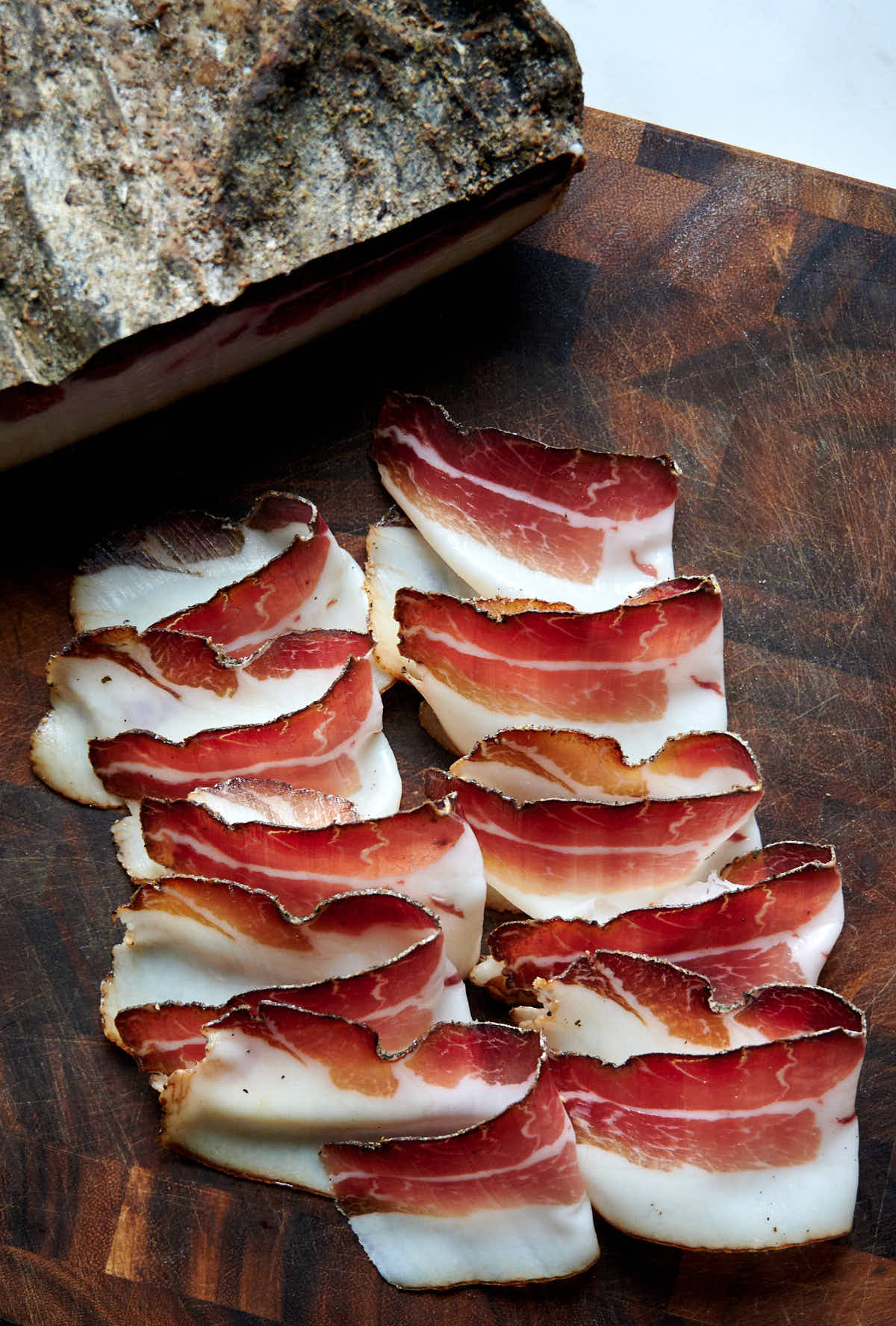
When I first tasted speck I immediately got hooked. It resembles prosciutto, only it is more aromatic, flavored by spices and smoke.
Speck is one of the easier salumi to make at home. It requires less skill to make than, say, prosciutto or culatello, but it's every bit as good, or better if you ask me. I've never made prosciutto or speck before and feel very excited about the opportunity to finally make this type of salumi a home. Prosciutto is a bit intimidating and requires a lot of space for a long time. Speck is not nearly as demanding, or intimidating. And you can always trim it to the size that suits your needs and use trimmings to make sausage.
Making speck
Preparing the meat
The most difficult part of making speck is correctly deboning, butterflying and trimming a pork leg. I started off with a whole leg of a Berkshire and Gloucestershire Old Spot mix pig that I purchased from Murray’s Farm. The video below shows how to do it correctly. I watched it a dozen times and was able to debone and butterfly the ham almost like in the video.
The only thing that I did differently was to trim my ham a bit more as I don't have a lot of free space in my curing chamber at the moment. Still, I ended up with a nice 9-pound piece.
Seasonings
The most common spices and seasonings used to make traditional speck are bay leaf, juniper berries, black pepper, nutmeg and rosemary. I've also seen some producers use garlic powder, which I like, so I included it as well. Some recipes include cloves, so feel free to add them if desired. When it comes to using seasonings in making salumi, less is more. You will need to use a precision scale to weigh out the spices in grams, like this Precision Pocket Weight Scale.
Curing
After trimming, I rubbed the boneless ham with salt and spices, placed it in a large Ziploc bag, expelled as much air as I could, sealed the bag and placed the meat in a fridge. The meat spent 21 days curing in the fridge. The smell of the seasonings is incredibly good. It's intense but not overwhelming.
Drying
After curing, I brushed off some excess seasonings and larger pieces of spices like cracked juniper berries and pieces of bay leaves and hung the ham in a drying chamber running at 68F and 75% humidity. The aromas of the spices blended and mellowed out. I find the smell irresistible; it's hard not to want to cut a piece of the meat and eat it straight away.
Smoking
Two days into drying, I began taking the meat out and cold-smoking it for 4 hours per day. The temperature in my smokehouse never exceeded 68F.
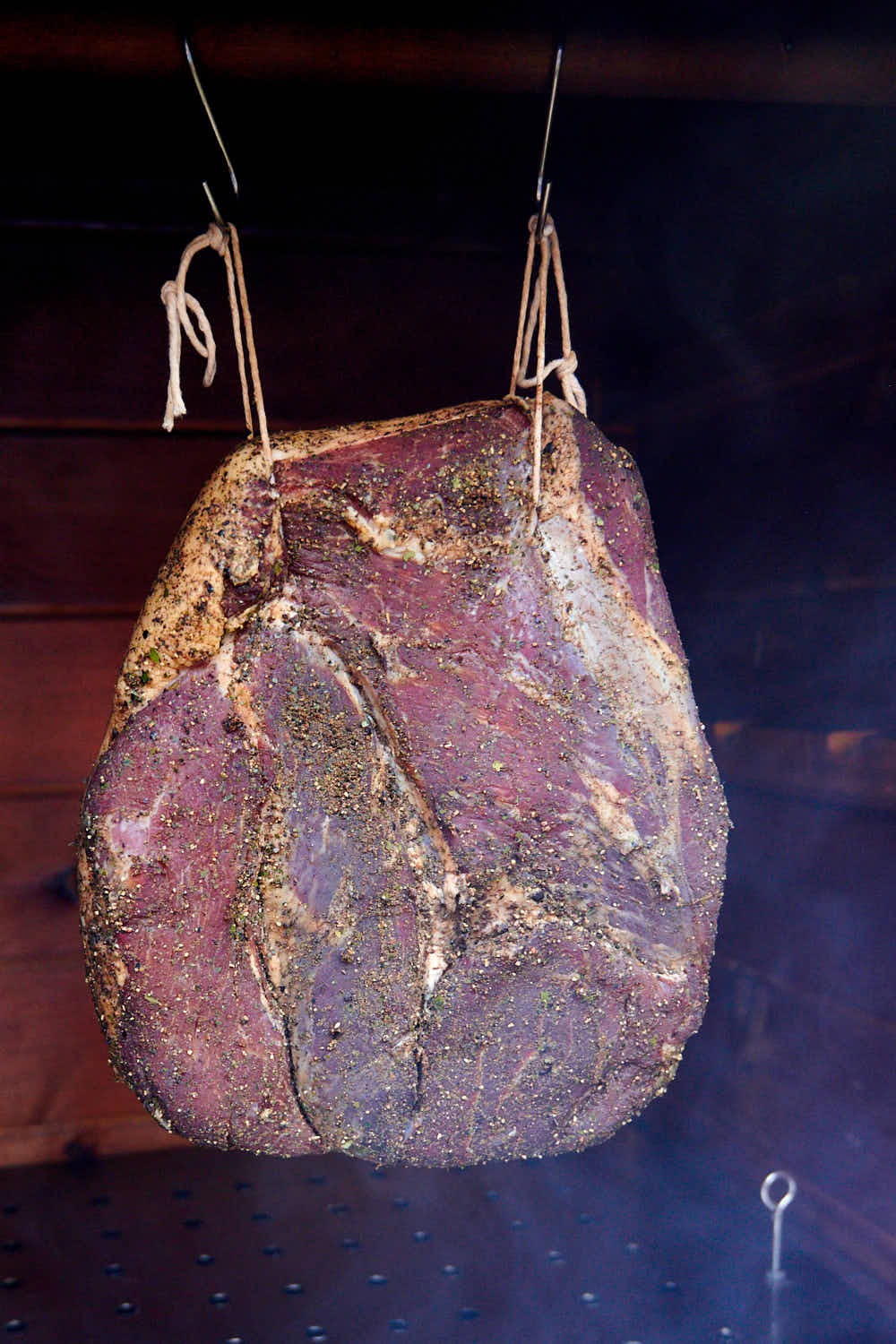
Traditional cold-smoking of speck requires four hours of smoking a day for up to 20 days using juniper, beechwood and ash. In between smoking, speck is caressed by the fresh mountain air. At home, wherever it is, you may have to use whatever you have on hand. Right now I only have access to oak, hickory and cherrywood so I chose to use oak and cherry for smoking. And since fresh mountain air doesn't blow here, I am going to assume that Toronto air is fresh enough.
Maturing
After drying and smoking, speck spends 6 - 12 and even up to 24 months maturing in stone cellars of Trentino-Alto Adige in Northern Italy, or in my case, in my meat curing chamber which is just as good, I am sure;)
Notes on smoking speck
- The success of smoking depends on the quality of the wood, quantity of smoke and smoke color and thickness. Avoid dark, thick smoke, Try to get thin blue smoke going.
- Smoke temperature - do not let the temperature exceed 68F (20C) as the meat will develop 'crust'. Too low temperatures prevent efficient smoke absorption.
- Smoke relative humidity - for cold smoking the humidity must be around 70-75% to avoid absorption of humidity by the food.
Weight loss progress
The speck that I liked the most was imported from Italy and had a very firm texture. I estimate that it had lost at least 45% of its green weight. It was outstanding and, sliced very thinly, was a delight to eat. The texture reminded me of that of my dry-cured sujuk. which I dry to 55% weight loss. I am not quite sure where the final weight loss will end up after 6 or more months of maturing but my target is 45%+.
| Weight | Loss, g | Loss, % | |
|---|---|---|---|
| Start | 4,106 | ||
| End of drying (15 days) | 3,622 | 484 | 11.8 % |
| 3 Weeks | 3,530 | 600 | 14.5 % |
| 1 Month | 3,387 | 719 | 17.5 % |
| 2 Months | 3,130 | 976 | 23.8 % |
| 3 Months | 2,974 | 1,132 | 27.6 % |
| 5 Months | 2,901 | 1,205 | 29.3% |
| 6 Months | 2,814 | 1,292 | 31.5% |
Tasting notes
At about 6 months of maturing time, the speck felt quite firm, though it had only lost about 32% of its green weight. This was quite far from my original estimation of a 45% target weight loss but I guess I forgot to account for the fat content in the ham. Fat typically loses very little weight compared to meat. No surprise, speck typically has about a 30%-35% weight loss by the time it is fully matured.
A touch of smoke, a hint of spiciness, just enough quite a bit of herb aromatics, and a whole lot of rich porky flavor. Aromatics are strong, mostly because of juniper. I liked them a lot at first but later I realized that I'd like to tone them down. Next time I make this recipe I will cut juniper by 4 and bay leaf and nutmeg by half.
Interestingly, I noticed a pleasantly tangy taste. Perfect saltiness, I wouldn't make even a slight change here. Incredibly tasty and a joy to eat. Sliced very thinly, it practically melts in your mouth.
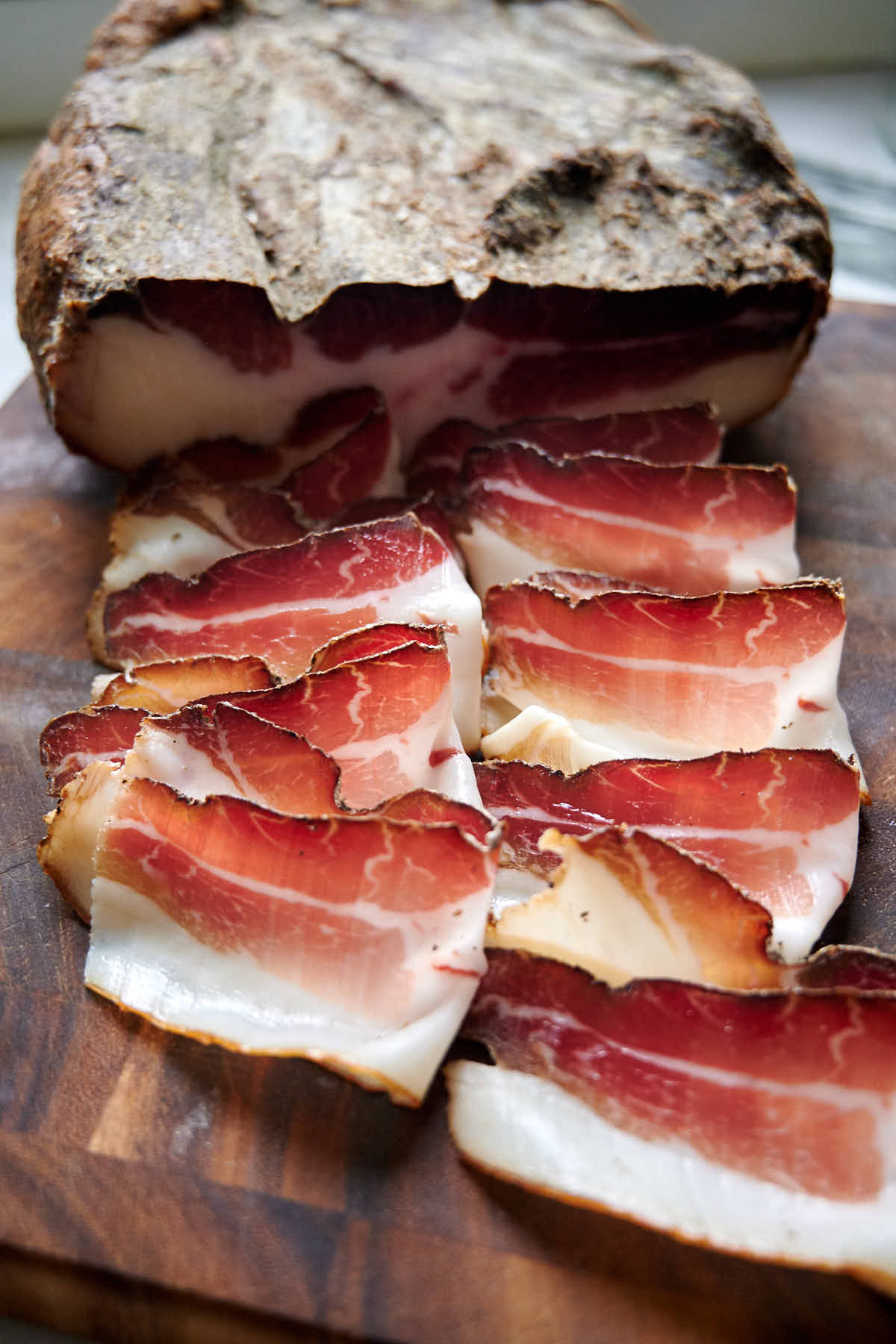
The fat, notably, is very tasty. While some of my family members aren't usually fond of fat, they all loved the fat in the speck. Perhaps it's the longer maturation time that made the fat more mellow, much more flavorful and more tender. I served it with homemade sourdough bread and slices of black beauty tomatoes from my garden drizzled with olive oil and a touch of freshly ground black pepper. Oh my! Delightful!
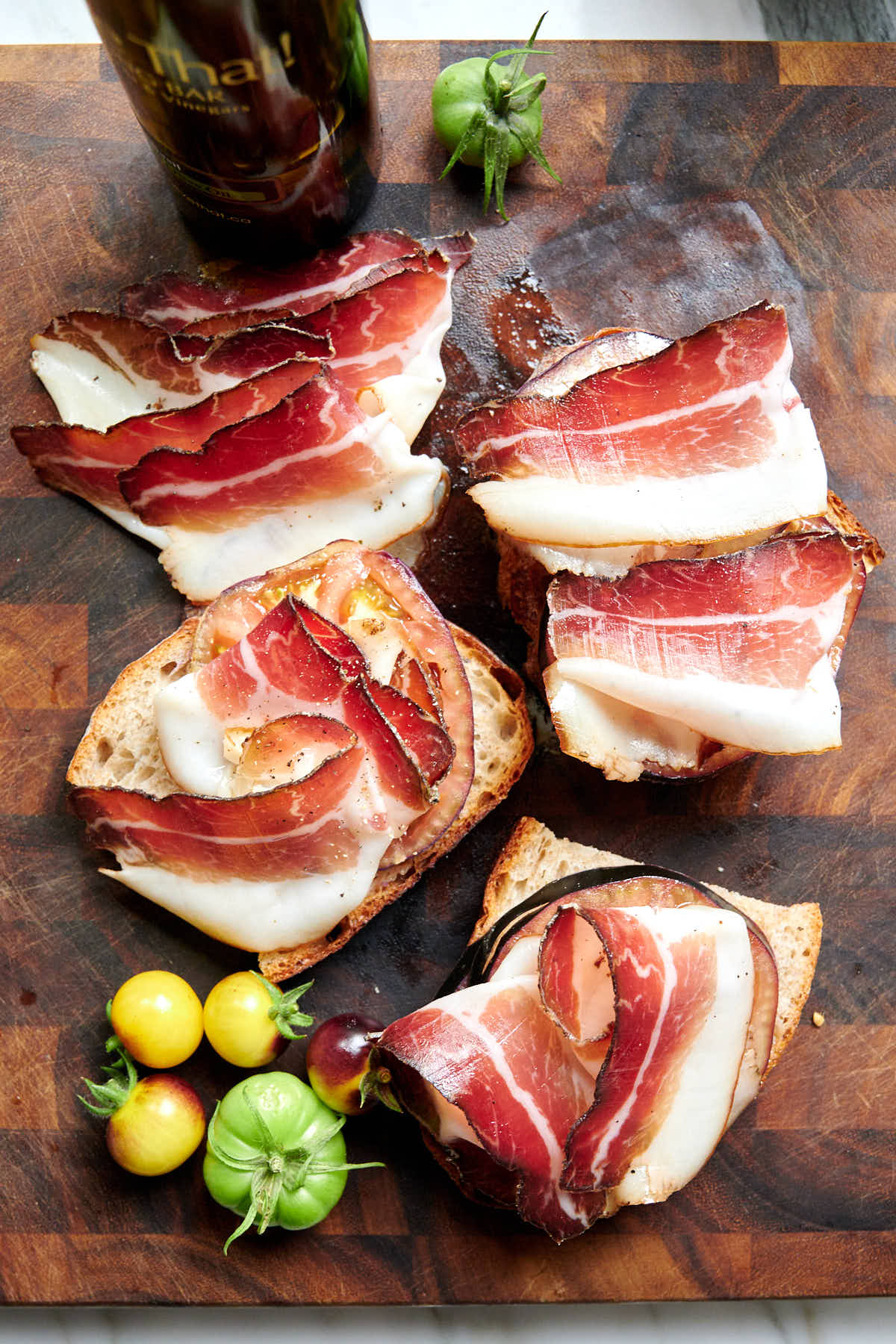
This is has got to be one of the tastiest salumi I've ever tried, either homemade or store-bought. I love Parma prosciutto, there is nothing like it, but this speck surely beats it in the flavor department. Proscuitto is a little more tender while this dry-cured speck has a slightly tougher texture. This is because it's cured with one side fully unprotected. This doesn't make it any less delicious though. But this means that you will have to slice it very thinly for best enjoyment.
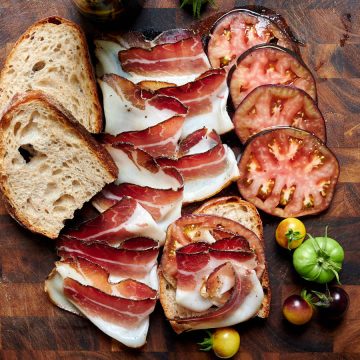
Homemade Dry-Cured Speck
Ingredients
- 1000 g pork leg ham
- 29.5 g kosher salt 2.95%
- 2.5 g Cure #2 0.25%
- 0.5 g bay leaf ground; 0.05%
- 0.5 g juniper berries 0.05%; cracked
- 2 g black pepper 0.2%; cracked
- 2 g garlic powder 0.2%
- 0.5 g nutmeg 0.05%; ground
- 2 g rosemary 0.2%; ground
Instructions
- Debone and trim the ham into a uniform shape as shown in the instruction video.
- Weigh the meat in grams. Divide by 1000, then multiply each ingredient by that number. For example, if your ham weighs 2650 g, you need to multiply the ingredients specified above by 2.65.
- Mix all the salt and the seasonings together, and rub on the meat. Place the ham and all the extra salt and seasonings in a vacuum-sealable bag and seal. You can also use a Ziploc bag.
- Place the bag in the fridge for 21 days. Flip the bag every day or so. Massage the meat 3 times over the first 7 days.
- After 21 days have passed, remove the meat from the bag and blot with paper towels.
- Dry in the curing chamber for 15 days at 68F (20C) and 75% RH.
- Cold-smoke for 4 hours a day for 15 days. If you can afford to smoke for just a few days, do that. The smoking temperature must not exceed 68F (20C).
- Mature in the curing chamber at 50F - 59F (10C - 15C) and 60% - 90% for 6-12 months.
- When the meat is ready, remove the skin, slice as thinly as possible and enjoy.
Notes
Nutrition


Pavel says
Hello! I have 2 questions: 1) Is it possible to dry smoked speck with dry-cured coppa in white mold together? Will the coppa also have a smoked taste? How can mold affect speck? 2) In your picture you have a fairly uniform piece of meat, although in the video you can see that the bone was separated and the meat is not uniform. If the meat is not uniform, can it start to spoil in the places where the bone was?
Victor @ Taste of Artisan says
I think it's doable, but, you may have to compromise a little. If you dry at a higher humidity, you will get white mold, hence why I prefer to mature it at lower humidity. If you get the mold, you can wash it off with wine later, or scrape it off with a knife. I personally try to not have mold develop on my speck as it has no casing. Curing a smoky meat with un-smoked meat won't result in the smoky flavor transfer. I've done it many times and I did not detect any smoky flavor in my unsmoked salami or solid meats after maturing them with smoked meats in the same chamber.
Yeah, it's more uniform and I think that's because I was very careful when deboning it, though there's only so much you can do there. But it's also because I trimmed off all the hanging pieces to come up with an even, uniform piece. I normally trim them off, so I don't know how they fare if left on. I am guessing they will dry out faster. Hope this helps.
Joseph Burnett says
i had a thin piece of pork belly left over and thougt try speck, however I have used cure #1 instead. would this be okay as the meat will be cooked anyway.
cheers
Joe
Victor @ Taste of Artisan says
Yes, just cure it and cook like you would bacon. Totally fine.
Joe says
thank you
John Dalen says
Does the above recipe reflect the 4x decrease in juniper and 2x decrease in nutmeg and bay leaf or is the above recipe the original? Thank you. Gonna give this a go next week with a Berkshire ham.
Victor @ Taste of Artisan says
John, I adjusted the recipe to reflect the decrease in those spieced. I mentioned it in the notes. Enjoy! Would love to see your pictires too.
Miklos horvath says
Nice
Fraser Bradbury says
Hi
I am using hams from young boar pigs so probably 1kg in weight. 21 days curing seems excessive, usually I cure a certain number of days per kg. Can you advise please
Victor @ Taste of Artisan says
Hi, sure, you can cure less. I don't use the days per kg formula but a week for very small pieces, 14 days for medium pieces and 21 days for large pieces is what I target. About 10-14 days for 1 kg should be enough. Since I measure out salt and seasoning specific to meat weight, there won't be over-salting or over-seasinig if that's what you are concerned about. Good luck!
Paul W says
Thanks for such a good detailed writeup.Just one question:
You have 21days for curing in the recipe. Is that for any thickness of meat? Doesn't the time for the cure to get right in vary with thickness?
Victor @ Taste of Artisan says
You are welcome. As far as curing time goes, 21 days is for curing a typical pig leg deboned the way it wash shown in the video. If your piece is significanly samller, then yes, you can reduce the curing time. Good luck!
Paul says
Hi Victor,
Newbie question for you - is it okay to freeze the pork before making speck? I was inspired by my recent trip to Italy to get into making my own speck and salumi. I inquired around at some farms here for a half hog, expecting to have to wait some months before my order could be filled. But a local farm just told me they’re actually selling half pigs right now for 5/Lb instead of the usual $6.50 because they’ve got a few too many at the moment. I think pick up would be next week or the week after. The problem is 1)I’m a newbie and won’t have my smoking and drying chambers ready for at least a month or two; 2) I assume it might be better to practice on some other charcuterie before trying with speck; 3) it’s the wrong season for cold smoking. So I’m wondering if I can get the pig in the next couple weeks but then freeze the leg until November or so. Is that verboten?
Thanks,
Paul
Victor @ Taste of Artisan says
Paul, I've read some people recommend only using frozen pork as that kills off potential pathogens like trichinae. But so does drying meat and trichinae cases in US/Canada have been practically eradicated. I've also heard an interesting point that frozen and thawed meat released a lot of water and making it better for curing. It makes sense to me. So, yes, you can use frozen pork. I never have, so I can't comment on any apparent differences in the final product.
Being a newbie, you will make a lot of mistakes, we all have. Don't rush, take it slow. Freeze that meat. You can always use fresh later.
Not having a proper setup will be a two-fold challenge - it will take time to set up and fine-tune. And things never go perfectly well. There is always some detail in the way.
Practicng on other other, smaller cuts is a good idea. Get a piece of pork butt, the neck part - money muscle. Make a capicola. SMoke it if you want. Or lonzino. Both are very easy to make and taste great. Good luck!
Gal Jerman says
Top ,.. top top ... post! Keep the good work on !
Victor @ Taste of Artisan says
Thank you. Will do.
John Kirstein says
Just what I wanted to hear, facts and helpful into, like my brain works!
Jay Beyer says
Hey Victor,
Do you know what would happen if you didn't have the skin on the pig leg?
Thanks!
Jay
Victor @ Taste of Artisan says
Jay, the skin protects the meat from drying out too fast even if only on one side. I've cured meat without skin and casings, it's doable but you need to keep an eye on them.
Nino Aramilo says
Hola, muy buen día..
Empiezo mi día leyendo sus recetas.. me parecen fantásticas.!
Soy Venezolano y debe usted conocer de nuestra situación política, es realmente idiotizante, lo que provocan es q desees algo que Dios no quiere pase por tu mente.. bueno,
Cyril Meurillon says
Hello again Victor,
thanks for the recipe! I think I will try that this coming week, with a twist. In the Austrian region of Tyrol where my wife is from, the most common form of speck is called Karreespeck and made with a pork loin cut rather than the leg. In a way, this is the alpine version of the Lonzino recipe you recently posted about -- i.e. skin-on, cured with additional spices and cold-smoked.
Another typical Austrian speck is Bauchspeck, made with pork belly (a variant of pancetta affumicata, from the other side of the Alps).
Thanks again for sharing your passion -- it's incredibly inspiring and contagious!
Happy Holidays!
Cyril
Victor @ Taste of Artisan says
Hey Cyril, no problem. Thanks for sharing this information, never heard of those. Well, I may have actually seen those when I lived in Germany or visited Austria but back then I wasn't really into charcuterie. Sounds like something I'd like to try... I just made a batch of salami and a bunch of bacon along with some culatello, lonzino and capicola so it will have to be sometime in the future. Checked some pictures online, I am in!!! Will be making these next time.
Happy holidays!
Dan fitzpatrick says
Looks absolutely fantastic. Ok, I gotta give this one a try. How big was the leg you started with, and how much meat you had to to then get down to 10 lb? I don't think my set up could go much bigger than that right now either. Also, what do you mean by dropping the juniper by 4?
Victor @ Taste of Artisan says
Thank you, Dan. Hm... I can't tell how big the leg was when I started, but it was fairly big. I bought half-pig from the local farmer and butchered myself. The whole pig was about 280 lbs hanging weight.
BY 'dropping by 4' I meant decreasing the amount by 4... so, a quarter of the original amount.
Good luck!
Leigh says
You Don't know how long I have been looking for this Recipe ...many thanks
Victor @ Taste of Artisan says
You are very welcome. Enjoy!
Leigh says
Quick Question Do you have to smoke it. Or can I skip that?
Victor @ Taste of Artisan says
You have to smoke it if you want to make it how it's made traditionally. It will be hard to do it in most of the northern hemisphere on account of the heat wave we are experiencing but if you are in Australia, cold smoking is perfectly doable at this time of the year.
Rob says
Beautiful work! I love your site. I’m just getting into curing and have a going with a similar recipe to yours. For my next project, I’m thinking about speck. Quick question about the butchering. I’m the video, it looks like they are leaving the skin on one side. Is that the case or am I mistaken? Thanks
Victor @ Taste of Artisan says
Hi Rob, thanks for the compliment. Yeah, leave the skin on, that's how they do it. When ready to consume, you can remove it or leave it on. I tried removing it at first but if you slice it paper-thin you don't even notice it. I think if you remove the skin, it will dry out too much too quickly. The skin allows it to dry more evenly at a slower pace to get proper maturation.
Greg says
Hi
Id like to try this and I have a few questions :
- did you press the meat while curing in the fridge? How does your final product look so flat vs the shape of the pork leg in the deboning video?
- I have a fridge that I converted to a curing chamber following your awesome setup (thanks so much for that article!!) that is at 55F but I don't really have a place to do the initial drying phase at a slightly higher temp. I was thinking using an electric smoker hooked up to a temperature controller to maintain temperature (during New England winters the outside temp will be very cold so just using the smoker heating element should be good no need to cool) and with a saturated salt solution to maintain humidity. That way I don't even need to move the meat for smoking? Any thought about that setup? Do you have experience using a saturated salt solution, I'm wondering how to do it and what volume it would have to be to maintain humidity in the smoker
Thanks
Victor @ Taste of Artisan says
Greg, no, I did not press the meat but it was vac sealed. I also trimmed it more than in the video because I wanted it smaller. I also cured it at the same time as a batch of bacon and I think at some point I stacked them on top of each other... so there you go.
The saturated salt solution, despite some reports from those who swear by it, has never worked for me. I am not saying that it doesn't work, but I think it works under certain conditions. The bottom line is - if you can get it to work for you, do it.
eric says
Looking really good. One thing that I haven't tried but it's on my to do list thanks to your post.
Victor @ Taste of Artisan says
Good luck. Hope it turns out as good or better than mine.
Dave says
This looks awesome, I've made a lot of sausages but nothing dry-cured yet. Do u have any posts on building a fermenting and cureing chamber. Thanks,will be watching
Victor @ Taste of Artisan says
Hi Dave, thanks... I just weighed it tonight, couldn't wait till it's been a month so weighed at 3 weeks, it has lost 14.5% of the green weight. It looks really good and the smell is very nice. I can't smell the seasonings any more, which were very aromatic and smelled very nice, but now there is mostly smoky flavor. The smokiness was a little intense and harsh initially but now, after a week, it mellowed out and smells very nice already. I think this one will be a real winner.
>
Yes, I posted an article about my dry-curing chamber many years ago which I have recently updated. There are quite a few charcuterie recipes on my blog, check them out.
Stefan says
Hi mate. I'm from Südtirol (Alto-Adige) but live in Australia. I grew up on a farm and my dad used to make Speck once a year. Your speck looks super delicous just like from home. I'll try to make it here in Melbourne as well. Thanks for sharing this.
Victor @ Taste of Artisan says
Stefan, thanks. It tastes super delicious too. I sharpened my meat slicer and sliced some super-thin last weekend... holy-moly... it was such a delight to eat. Definitely more flavorful than prosciutto... Will be making a couple of these next year for sure.
Rob says
I've been considering trying Culatello or even Proscuitto, but I may give this a try instead since it's less intimidating and less time consuming. I might try two separate pieces - one smoked and one not. The latter should be similar to proscuitto, just not aged as long.
No casing needed? I wonder if the meat side might get a little dried out.
Victor @ Taste of Artisan says
Hi Rob, speck is never encased, that's how it's traditionally made. You can see how it looks here - https://www.youtube.com/watch?v=fi5pNcNZfQI. Jump to 20:09. It looks quite firm... I think if I dry it for 2 weeks at 75% and then mature at higher humidity it should be fine. I have a bunch of salami in the chamber right now maturing at 80-86% so I have to keep the speck at that humidity as well. It shouldn't dry out at that humidity. If you go lower, it may very well do.
>
Not smoking one may present a bit of a problem. Smoke keeps molds away... You may have to cut all that moldy surface off before cutting... a bit of waste ... but may not be a problem, I am just speculating here...
Nino Aramilo says
Hola.. muy buen día..
Soy Venezolano y usted conocer por lo estamos pasando, lamentablemente. Quisiera información de ayuda, me gustaría incursionar en esto de los embutidos. Gracias
Victor @ Taste of Artisan says
Hello, Nino. It's a terrible thing that's happening to your country, and other countries, like Ukraine. I really hope to see things turn for the better soon, especially in Ukraine. Good luck with your meat curing adventure, I'll be more than happy to help you any information you may need to get you started. Let me know and best of luck.